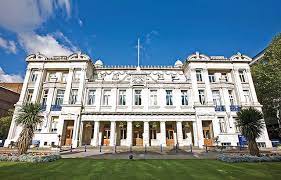Queen Mary University of London’s exhibition celebrates ‘twin towns’ building bonds across borders
‘LINES: making friends; crossing borders’ combines eight striking posters with a visual fieldwork diary to present findings of a four-year research project on the relatively unexplored area of twin towns by Dr Holly Eva Ryan, Senior Lecturer in the School of Politics and International Relations at Queen Mary.
Dr Ryan has studied twin town partnerships across the world, some dating back to the 1950s and others newly created, looking to define ‘international friendship’ and understand its value. As well as mapping how the practice of ‘twinning’ has evolved over time, from its post-war peacebuilding origins in Europe to serving broader political and moral agendas, her research highlights how art and cultural exchange help to build and maintain these relationships.
While twin towns were first created to support cultural diplomacy, Dr Ryan’s work examines how twinning has since featured in struggles to challenge and change the course of global political affairs, offering a new perspective on the historic practice in a constantly changing and often divided international landscape.
Artwork displayed in the exhibition depicts real world examples of twinning’s powerful impact – from supporting the 1990s anti-apartheid movement in South Africa, when towns in England and Scotland twinned with African National Congress regions, to dismantling the historically contested border between Italy and Slovenia with a twin town partnership that will make Gorizia and Nova Gorica the joint 2025 European Capital of Culture.
Other examples include Reading’s twin town partnership with Speightstown in Barbados recognising the crucial role that Barbadians played in British development, humanitarian aid efforts in Glastonbury’s Ethiopian twin town Lalibela when political extremists invaded, and Oxford work to support Palestinian refugees in twin town Ramallah during occupation by the Israeli Defence Force.
The exhibition also portrays the Denver and Nairobi twinning that led to the return of cultural objects from museum displays to their rightful owners, a partnership between Scottish and Mexican communities to support indigenous communities, and the dozens of UK and US towns twinned with Nicaragua to help civilians in the wake of the 1979 revolution.
Dr Ryan explained: “This exhibition is about ‘twinning’, but not as you currently know it. The European town twinning project in the wake of the Second World War has been well charted by academics, journalists and literary figures – but we rarely hear about twin towns in the wider world, where the practice has created a huge range of complex cultural connections in recent years, disrupting power dynamics and challenging the status quo.
“While some twin town relationships have a straightforward focus on courting business and investment from abroad, others aim for lofty goals like cultural diplomacy and peacebuilding. This exhibition details the intricate meld of emotional intensity, moral compulsion and political zeal unleashed by twinning across the globe.”
Dr Ryan commissioned Manchester designers Minute Works Ltd to create eight bold graphic images that depict different impacts of twinning, which are displayed in the exhibition with a multimedia fieldwork diary to give unique insight on the research process. The project was funded by the Economic and Social Research Council.

